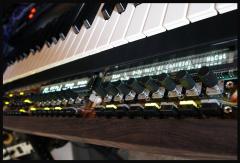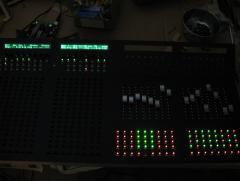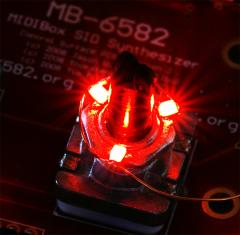
lucem
Programmer-
Posts
253 -
Joined
-
Last visited
-
Days Won
1
Content Type
Profiles
Forums
Blogs
Gallery
Everything posted by lucem
-
Wie gestern bereits gesagt würde ich vor heute abend nicht an EAGLE zu sitzen kommen, von daher kann ich noch keins meinerseits fertig haben.
-
Zu Luftlinien: Ratsnest ist ja auch nicht zum Verbinden von Signalen da. Der Befehl sucht lediglich die kürzeste Verbindung zwischen Traces und/oder Pads. Verlegen muss man die dann noch von Hand bzw Vias setzen, wo angezeigt.
-
Vielleicht ja nach ner kurzen Zeit Abstand von dem Gerät weitermachen. DIY ist leider manchmal frustrierend, aber es gibt genug Leute hier, die dir dabei gerne helfen, die Klippen sauber zu umschiffen :)
-
Wobei zu bedenken bleibt, dass Platinenfläche (variabel) im Gegensatz zu Einrichtungskosten (fix) im Vergleich günstig ist bei der Leiterplattenherstellung. Ich würde mal ausprobieren wollen, wie sich die Platine verkleinern lässt, wenn man die SMD-ICs beidseitig (versetzt) bestückt. Leider würde ich da heute nicht mehr zu kommen, da ein Testlayout zu bauen, sonst würde ich das selbst machen, aber vor morgen Abend keine Chance. Wenn bis dahin noch kein Layout im Thread zu sehen ist werd ich mich da mal selbst dran machen.
-
Hm, auf den ersten schweifenden Blick kann man da sicher noch das ein oder andere an Platz optimieren. Erlaubt Seeed das beidseitige SMD-Bestücken?
-
Es sollte doch kein Problem darstellen, neben den Spezialwünschen auch eine standardkonforme SMD-Version anzufertigen. In dem Fall hat jeder was davon.
-
The way Augmenter as a system is conceived cannot be easily explained in one sentence. The first thing to realize is that it is a whole guitar amplification system. It consists of several components, and this compartmentalization is what makes this doable, regardless of the size of the circuit. So let's run down the signal chain. Starting from the guitar and cable, we arrive in the first major building block, which is the pedalboard unit. This consists of several analog fx pedals, a BOSS GT-8 multi-effects unit, a DI and ReAmping interface, and the digital circuitry involved in making the connections between those parts. From there on, by means of a balanced feed of several meter length, we move into the actual amplifier. this one consists of two booster stages, level adaption circuitry, another DI-Interface, four preamp channels with flexible tone stacks, two effects loops, two output EQs, and several types of power amplifiers, so output power can be selected due to the prevalent environment. And, of course, there is some digital control means implemented here as well, interconnected by MIDI with the pedalboard, or controlled by any other MIDI controller for that matter. So, in essence, there will be two cables running between the pedalboard and the amp head, and that's it. That's the system I have in mind, and right now I'm feverishly drawing up circuit diagrams to design the components of this system. My personal goal is to make all this fit onto a single 155 square inch circuit board to order from goldphoenix, which I would seperate into individual modules manually, and build any missing stuff on perfboard. The midibox NG seems like the right start to base the pedalboard switching system on, and the money is still out on the (somewhat simpler) amplifier switching system. If I manage to obtain a crossbar switch IC, I will use that as a rather elegant switching solution. The power amps I have in mind and that I'd like to implement are LM386, TDA1517, TDA2003 (or TDA 2050) and LM3886. I opt for integrated power amplifiers because, in all fairness, they offer way better quality than anything that can be discretely built (as long as you provide proper cooling and won't let them clip). Tubes are out of the question for me; however much I like the sound of tubes, they're just a pain in the ass to get right, and the heat and inevitable wear makes them very problematic. One thing I want to avoid like the plague is ground loops, and thus every connection between independently powered devices (pedalboard, amp head, GT-8, ReAmp input, D.I. outputs) is isolated by using signal transformers, eliminating any chance of forming a hum loop.
-
After a longer time of absense from the forums, I'm currently in the design phase for something new. As it happens, midibox plays a larger part in what I'm cooking up right now, and so I thought I'd share little bits and pieces along the way. The topic of this project revolves around (guitar) amplification. This involves a lot of analog circuitry, but nevertheless a great deal of digital control by means of midibox hardware & MIOS software, and who knows, maybe one or two people might actually find it interesting. Thus, I give you (in a series of posts I will hopefully have the stamina to actually follow through with): Augmenter.
-
If you can draw a map of the matrix implementation, you most certainly can change it in software.
-
-
Vom Prinzip her wird sich sicherlich jemand finden. Da allerdings mein eigener PIC-Brenner gerade irgendwo in einer Kiste rumgammelt, würde ich bevor ich mich selbst dafür anbiete erstmal schaun, ob sich noch jemand meldet.
-
Ebony MBSEQ V4 installed below keyboard
lucem commented on Hawkeye's gallery image in Members Gallery
-
Ebony MBSEQ V4 installed below keyboard
lucem commented on Hawkeye's gallery image in Members Gallery
-
Ebony MBSEQ V4 installed below keyboard
lucem commented on Hawkeye's gallery image in Members Gallery
-
-
This community is all about the DIY spirit and freedom from commercial background. The thing is, it's not that most people around here would totally dislike commercial activity - the requirement is, that this activity benefits the community and not just makes money from other people's work. The two sanctioned places to sell midibox hardware are run exactly to provide that. People sticking around long enough have seen people trying to do somethin commercial, or doing unsanctioned knock-offs, come and go, and I can't remember one of them leaving a good impression. This is why people coming in talking about commercial ideas in their first posts are usually not well received... It's not about "buy a premade board" - it about "build your box". If you can design your own boards, make them and run them all the way through, do so - for yourself, or even people in the community that may use them (ultra's ultracore is a prominent example of that). Just note that in order to sell these designs, if they incorporate anything of the midibox platform, like in implementation of board schematics, or software delivered with it, it needs sacntioning by the copyright owner (which would be TK). Anything done for the community and openly done in the community, like making a batch of boards and sharing the cost with other people, is usually fine. The premade boards are for the people that don't want to make their own ones, or can't. They're not a requirement per se. Regarding commercial or semi-commercial activity in the community, there are good examples around of things that are possible and can work out. Anything offered that doesn't touch other peoples copyright material is your own decision to do, e.g. if you come up with a new module for a new application, that's your design and your copyright, and you are free to do with that how you like. However, people in this community like stuff free as in freedom, and some as in beer. This means that anything that's closed up will unlikely be very successful.
-
Backlighting transparent knobs for the MB6582
lucem commented on Hawkeye's gallery image in Members Gallery
-
Doesn't run MIOS so officially not a user project..
lucem replied to NorthernLightX's topic in Miscellaneous
On the part "doesn't run MIOS", not convinced yet ;) Anyway, congratulations, great build :) -
And the specs hint that it's essentially a BeagleBoard, at least very similar ;)
-
Den Matrix-Treiber kannst du meines Wissens in die SeqV4-Anwendung mit eincompilieren. Du brauchst dafür keinen zusätzlichen Controller. Sprich: bei V4 läuft alles auf dem Core32; kein Core8 nötig.
-
Sorry, ich werd aus deiner Frage nicht schlau.
-
So ziemlich jede Si-Diode in Vorwärtsrichtung ist verwendbar - 1N4148 ist allerdings die häufigste Variante.
-
Oh, the good old days of guru meditation ;)





